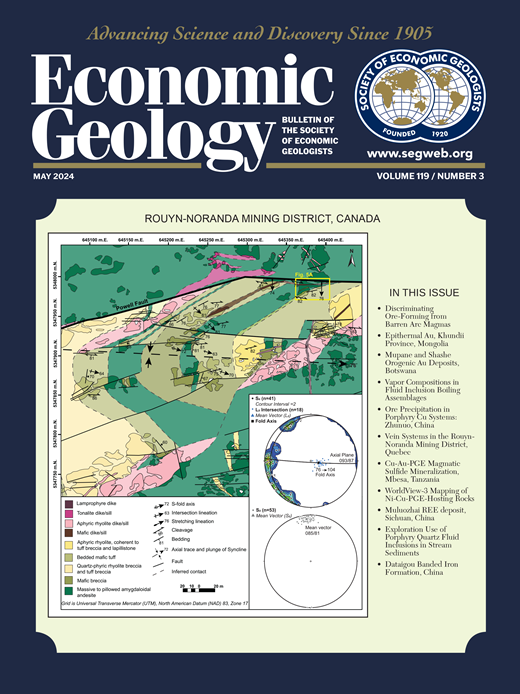美国内华达州Cortez Hills carlin型金矿流纹岩侵入时间与carlin型金矿化
IF 5.5
1区 地球科学
Q1 GEOCHEMISTRY & GEOPHYSICS
引用次数: 2
摘要
内华达州卡林型金矿(CTDs)是美国最大的黄金生产地,在世界黄金生产中处于领先地位。尽管关于内华达CTDs的特征和起源已经有了很多解决方案,但主要问题仍然存在,特别是(1)岩浆作用的作用,是否只是一个热源还是金属的来源,(2)CTDs是否只形成于始新世,(3)前始新世的金属浓度是否对始新世的矿床有贡献。这些问题以Cortez地区的ctd为例,该地区是这些矿床仅次于Carlin趋势的第二大集中地。卡林型矿床很难测定年代,因为它们很少产生可测定年代的矿物。年龄可以通过与年代久远的岩脉和其他侵入物的横切关系推断出来,我们已经对巨大的科尔特斯山CTD进行了这样的研究。我们所称的“Cortez流纹岩”由两组硅质岩脉组成:(1)石英-矽晶-斜长石-黑云母-辉岩,高sio2流纹岩,根据大量的40Ar/39Ar年代学,侵位在35.7 Ma;(2)斜长石-黑云母-石英±角闪石-辉岩,低sio2流纹岩,可能是同时侵位的,但可能早在~36.2 Ma。岩脉以Cortez Hills矿床为中心,呈nnw走向,宽约6 ~ 10 km,长约40 km,需要下部长英质岩体为岩脉提供补给。这些岩脉是成矿前还是成矿后一直争论不休。研究表明,岩脉侵位跨越了成矿时期。许多高sio2和低sio2岩脉都被蚀变和矿化,尽管它们都不构成矿石。在蚀变矿化的岩脉中,斜长石被高岭石和方解石所取代,黑云母被蒙脱石、方解石和马闪石所取代。除少数样品完全蚀变为石英和高岭石外,硅胺未发生变化。矿化岩脉中的硫化物有黄铁矿、黄铁矿、毒砂和含砷锑黄铁矿。矿化岩脉中等富集卡林型元素(Au、Hg、Sb、Tl、As和S),以及某些CTDs中发现的元素(Ag、Bi、Cu、Mo),而MgO、CaO、Na2O、K2O、MnO、Rb、Sr和Ba则不同程度地贫化。而部分高sio2流纹岩则未蚀变,且切割出高品位矿石,表明其为后矿石。矿化和矿后岩脉具有难以区分的40Ar/39Ar年龄。这些特征,连同其他巨型CTD在几万年内形成的已发表的解释,表明科尔特斯山CTD形成于35.7 Ma。所有科尔特斯地区的CTDs都位于或邻近科尔特斯流纹岩岩脉群,这表明滋养岩脉的长英质岩体是热液热源。岩脉与典型古生代沉积岩型矿石在蚀变和地球化学上的微小差异,可能反映出以石英岩为主的岩脉渗透率低、反应性低。尽管在Cortez地区广泛存在35.7 Ma以前的成矿作用,包括几个CTDs附近的矿床,但我们没有发现更古老的矿床或古生代盆地岩石为Cortez地区的CTDs贡献金属的证据。结合我们关于Cortez Hills年龄的新信息与我们对其他CTD的出版和我们的日期表明,CTD的形成与岩浆活动穿过内华达州的西南迁移相吻合,支持始新世岩浆活动的遗传关系。在深部(~ 6-8 km),可能是花岗岩岩体,在矿床中仅以岩脉形式表现,建立大型对流热液系统的地方,CTDs发育最好。本文章由计算机程序翻译,如有差异,请以英文原文为准。
Timing of Rhyolite Intrusion and Carlin-Type Gold Mineralization at the Cortez Hills Carlin-Type Deposit, Nevada, USA
Carlin-type gold deposits (CTDs) of Nevada are the largest producers of gold in the United States, a leader in world gold production. Although much has been resolved about the characteristics and origin of CTDs in Nevada, major questions remain, especially about (1) the role of magmatism, whether only a source of heat or also metals, (2) whether CTDs only formed in the Eocene, and (3) whether pre-Eocene metal concentrations contributed to Eocene deposits. These issues are exemplified by the CTDs of the Cortez region, the second largest concentration of these deposits after the Carlin trend.
Carlin-type deposits are notoriously difficult to date because they rarely generate dateable minerals. An age can be inferred from crosscutting relationships with dated dikes and other intrusions, which we have done for the giant Cortez Hills CTD. What we term “Cortez rhyolites” consist of two petrographic-geochemical groups of siliceous dikes: (1) quartz-sanidine-plagioclase-biotite-phyric, high-SiO2 rhyolites emplaced at 35.7 Ma based on numerous 40Ar/39Ar dates and (2) plagioclase-biotite-quartz ± hornblende-phyric, low-SiO2 rhyolites, which probably were emplaced at the same time but possibly as early as ~36.2 Ma. The dikes form a NNW-trending belt that is ~6–10 km wide × 40 km long and centered on the Cortez Hills deposit, and they require an underlying felsic pluton that fed the dikes. Whether these dikes pre- or postdated mineralization has been long debated. We show that dike emplacement spanned the time of mineralization. Many of both high- and low-SiO2 dikes are altered and mineralized, although none constitute ore. In altered-mineralized dikes, plagioclase has been replaced by kaolinite and calcite, and biotite by smectite, calcite, and marcasite. Sanidine is unaltered except in a few samples that are completely altered to quartz and kaolinite. Sulfides present in mineralized dikes are marcasite, pyrite, arsenopyrite, and As-Sb–bearing pyrite. Mineralized dikes are moderately enriched in characteristic Carlin-type elements (Au, Hg, Sb, Tl, As, and S), as well as elements found in some CTDs (Ag, Bi, Cu, Mo), and variably depleted in MgO, CaO, Na2O, K2O, MnO, Rb, Sr, and Ba. In contrast, some high-SiO2 rhyolites are unaltered and cut high-grade ore, which shows that they are post-ore. Both mineralized and post-ore dikes have indistinguishable sanidine 40Ar/39Ar dates. These characteristics, along with published interpretations that other giant CTDs formed in a few tens of thousands of years, indicate the Cortez Hills CTD formed at 35.7 Ma. All Cortez-area CTDs are in or adjacent to the Cortez rhyolite dike swarm, which suggests that the felsic pluton that fed the dikes was the hydrothermal heat source. Minor differences in alteration and geochemistry between dikes and typical Paleozoic sedimentary rock-hosted ore probably reflect low permeability and low reactivity of the predominantly quartzofeldspathic dikes.
Despite widespread pre-35.7 Ma mineralization in the Cortez region, including deposits near several CTDs, we find no evidence that older deposits or Paleozoic basinal rocks contributed metals to Cortez-area CTDs. Combining our new information about the age of Cortez Hills with published and our dates on other CTDs demonstrates that CTD formation coincided with the southwestern migration of magmatism across Nevada, supporting a genetic relationship to Eocene magmatism. CTDs are best developed where deep-seated (~6–8 km), probably granitic plutons, expressed in deposits only as dikes, established large, convective hydrothermal systems.
求助全文
通过发布文献求助,成功后即可免费获取论文全文。
去求助
来源期刊

Economic Geology
地学-地球化学与地球物理
CiteScore
10.00
自引率
6.90%
发文量
120
审稿时长
6 months
期刊介绍:
The journal, now published semi-quarterly, was first published in 1905 by the Economic Geology Publishing Company (PUBCO), a not-for-profit company established for the purpose of publishing a periodical devoted to economic geology. On the founding of SEG in 1920, a cooperative arrangement between PUBCO and SEG made the journal the official organ of the Society, and PUBCO agreed to carry the Society''s name on the front cover under the heading "Bulletin of the Society of Economic Geologists". PUBCO and SEG continued to operate as cooperating but separate entities until 2001, when the Board of Directors of PUBCO and the Council of SEG, by unanimous consent, approved a formal agreement of merger. The former activities of the PUBCO Board of Directors are now carried out by a Publications Board, a new self-governing unit within SEG.
 求助内容:
求助内容: 应助结果提醒方式:
应助结果提醒方式:


